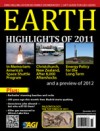 Early in his career, Paul Olsen sat in front of a television, expecting to see his own image. He had hosted a television crew on a research expedition to Manicouagan Crater in Canada, where he and his team were investigating the Triassic–Jurassic boundary in the geological record. Olsen, a palaeontologist at Lamont–Doherty Earth Observatory of Columbia University in Palisades, New York, had spent hours explaining and re-explaining for the camera how scientists used the site to reconstruct ancient ecologies. As the opening credits rolled, Olsen wondered how he would come across on the small screen.
Early in his career, Paul Olsen sat in front of a television, expecting to see his own image. He had hosted a television crew on a research expedition to Manicouagan Crater in Canada, where he and his team were investigating the Triassic–Jurassic boundary in the geological record. Olsen, a palaeontologist at Lamont–Doherty Earth Observatory of Columbia University in Palisades, New York, had spent hours explaining and re-explaining for the camera how scientists used the site to reconstruct ancient ecologies. As the opening credits rolled, Olsen wondered how he would come across on the small screen.
Tag Archives: Planetary science
Mantle Recycles Far Faster Than Thought
 The magma that rises from the mantle, forming new islands, may blast more than it bubbles. Where those plumes of magma originate — at the core-mantle boundary or the mantle-crust boundary — and how fast they rise to the surface are still open questions among volcanologists. But now a new study of minerals from the volcano Mauna Loa on the Big Island of Hawaii suggests that some elements made a 2,900-kilometer-long journey from the core-mantle boundary to Earth’s surface in as little as half a million years — quadruple the speed found by previous studies. Continue reading Mantle Recycles Far Faster Than Thought
The magma that rises from the mantle, forming new islands, may blast more than it bubbles. Where those plumes of magma originate — at the core-mantle boundary or the mantle-crust boundary — and how fast they rise to the surface are still open questions among volcanologists. But now a new study of minerals from the volcano Mauna Loa on the Big Island of Hawaii suggests that some elements made a 2,900-kilometer-long journey from the core-mantle boundary to Earth’s surface in as little as half a million years — quadruple the speed found by previous studies. Continue reading Mantle Recycles Far Faster Than Thought
Extreme Weather More Frequent in Northern Europe
 Northern Europe may have gotten stormier since the late Victorian Era. Looking at a fresh analysis of old atmospheric pressure data, researchers found that the annual number of windy days may have risen by one to five days per century in parts of northern Europe, and the intensity of such storms may have grown too. Continue reading Extreme Weather More Frequent in Northern Europe
Northern Europe may have gotten stormier since the late Victorian Era. Looking at a fresh analysis of old atmospheric pressure data, researchers found that the annual number of windy days may have risen by one to five days per century in parts of northern Europe, and the intensity of such storms may have grown too. Continue reading Extreme Weather More Frequent in Northern Europe
Rumbles in the Alps reveal rockslides
The ricochet of a rock fall resonates in the mind of anyone who has heard it. But it also sets off subterranean waves detectable by far-off seismic stations — and now researchers are using those signals to remotely model rockslides.
Franziska Dammeier, an engineering geologist at the Swiss Federal Institute of Technology in Zurich, and her colleagues linked five metrics of seismic waves to five physical characteristics of rockslides: volume, runout distance (how far the rocks travel), drop height, potential energy and the angle of reach. The researchers reported their model last week in the Journal of Geophysical Research. Continue reading Rumbles in the Alps reveal rockslides